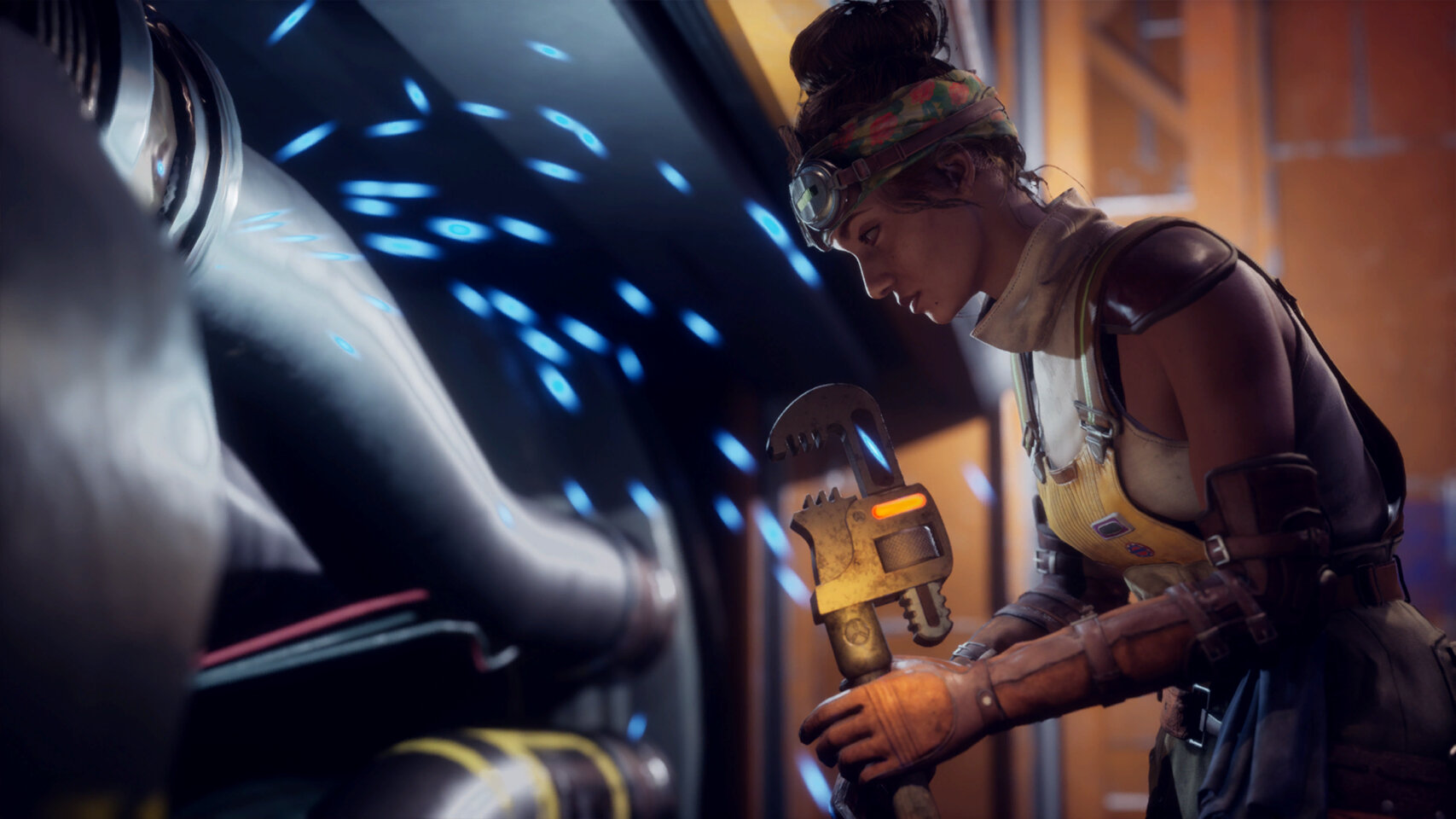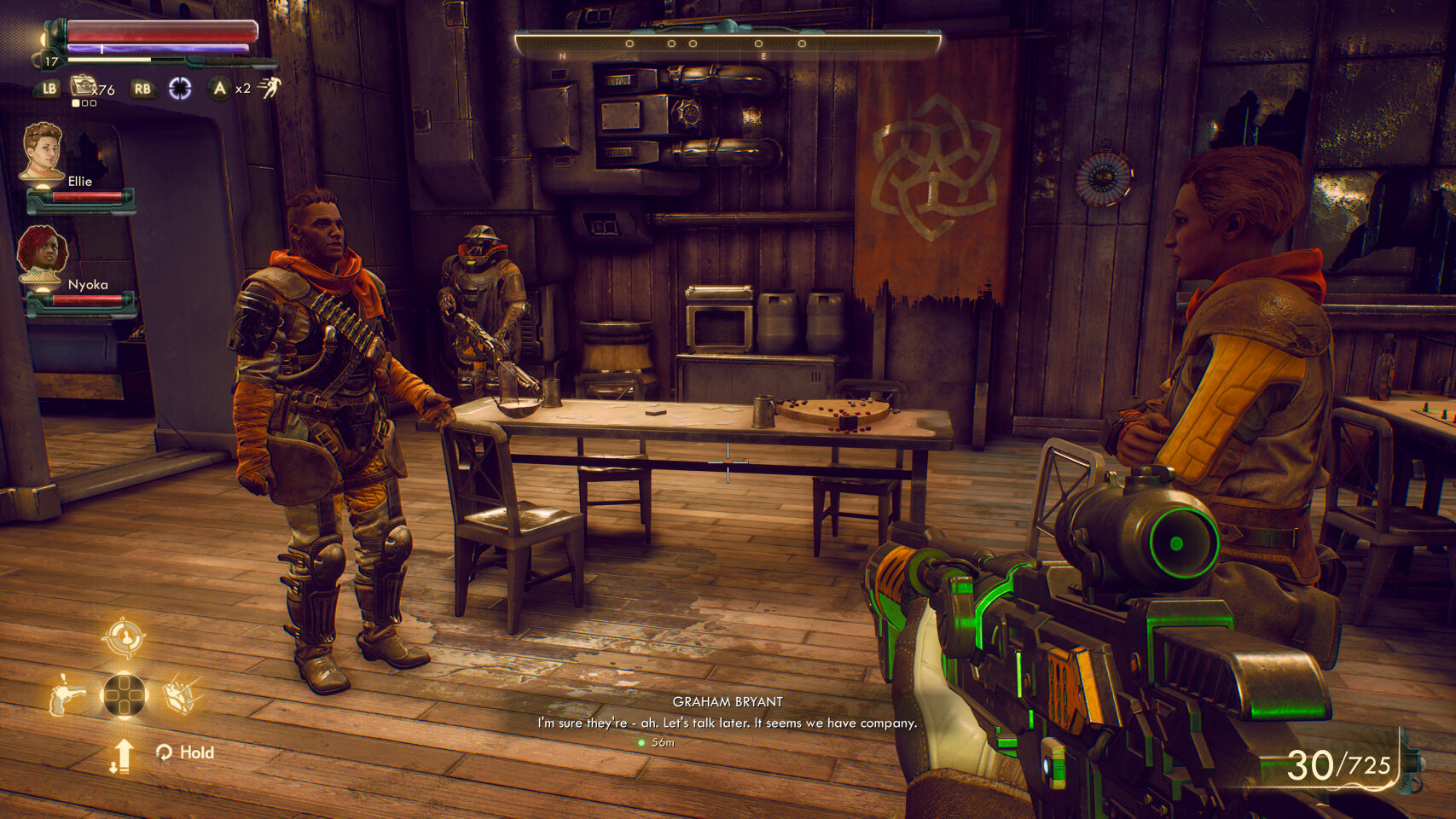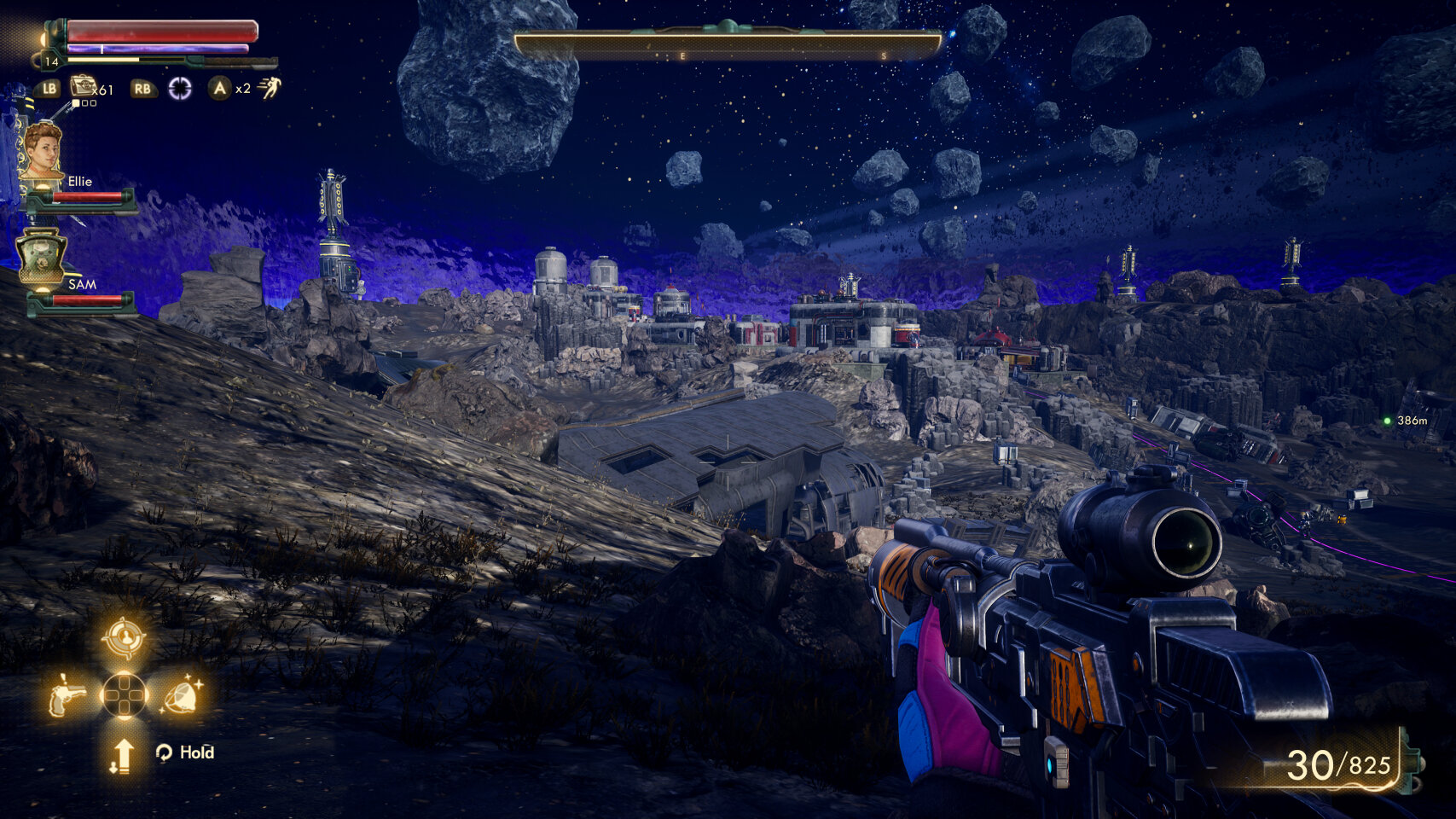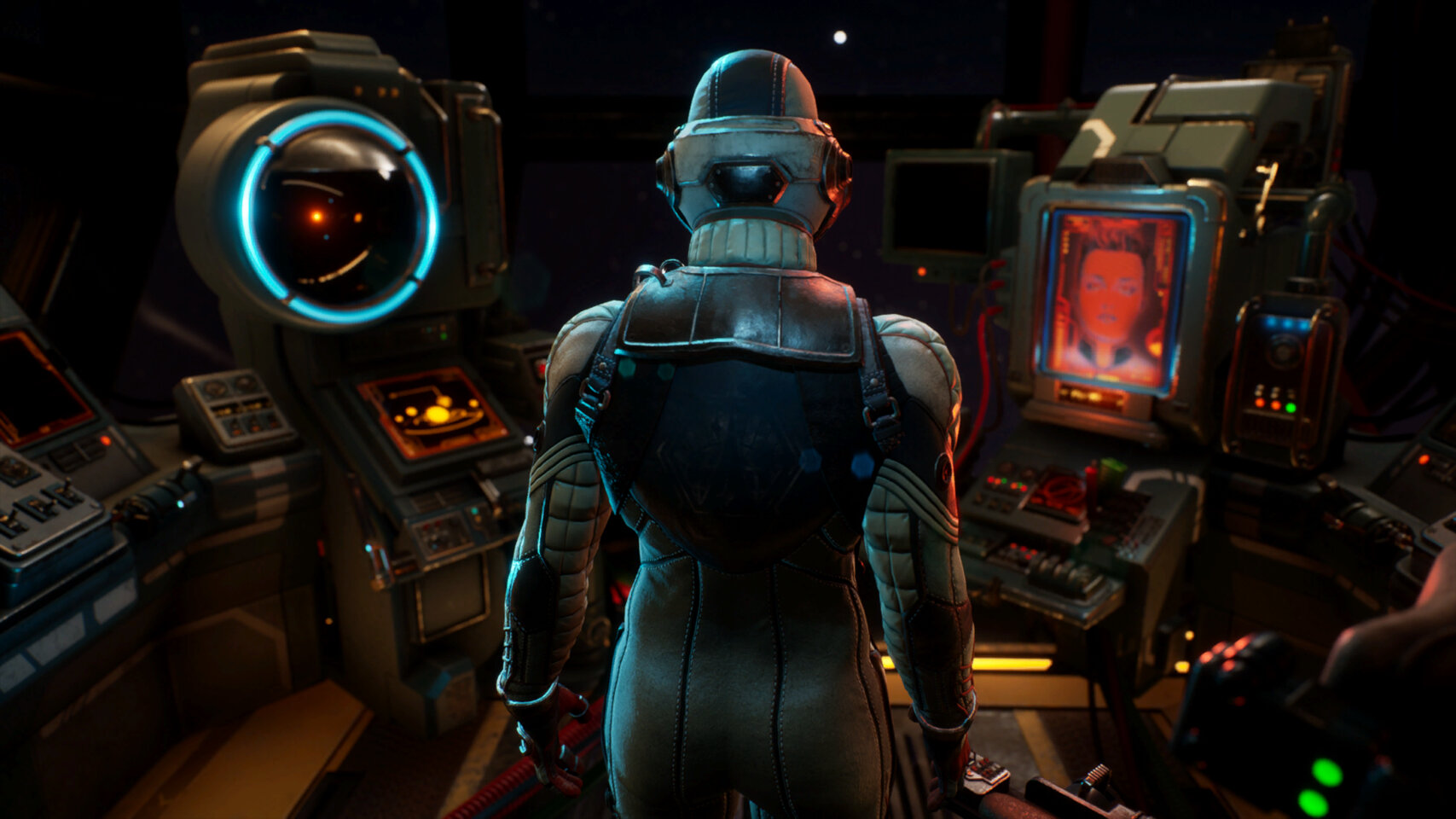Outer this World.
Regardless of your playstyle, The Outer Worlds will have you contemplating the vast choices given to you when approaching not just combat, but the various ways dialogue can have a huge effect on the outcome. Do you look to take on an armed armada waiting for you in the far reaches of space, or bluff your way out of a confrontation by threatening them with issuing a self destruct order? This choice, among many, is backed up by superb writing, a fairly endearing cast of characters, and engaging confrontations, where words can often be more powerful than laser fueled ammunition.
Developed by Obsidian Entertainment, the studio behind the beloved Fallout: New Vegas, which has been arguably declared the greatest of the Fallout adventures, has sought out to return to that very formula. For as much originality that The Outer Worlds provides, it very clearly plays tribute to Fallout: New Vegas in more ways than one. While the title has seen comparisons to all sorts of games such as Mass Effect and Bioshock, its roots are firmly planted in being the Fallout alternative. Given Bethesda’s problems with Fallout 76, and the fact it’s a live service game, The Outer Worlds feels needed more so than ever. And, at least in my opinion, it is better than Fallout has ever been.
The Outer Worlds’ structure is this; you will explore a number of planets via your ship, gathering companions to fight alongside you, and take on a varied selection of quests while also looking to save a colony ship packed full of its cryogenically frozen residents. As one of those frozen people unthawed by who is essentially a mad scientist, you discover that the Halycon system, the section of space you awaken to, is in dire need of help. As you move from planet to planet, you’re tasked with tracking down information and various things needed to unthaw your fellow passengers and in the process, address the concerns of the system. It’s a huge weight put on your shoulders, but given the availability of choice, you can pretty much ignore that and become a corporate sellout instead.
Choice is frankly the biggest option given to you in The Outer Worlds. You can choose if you want a certain companion to join your ragtag team, or you can walk up to the first corporate stooge and sellout your scientist friend who has been working in the shadows for years attempting to help your people and thus is currently being sought after by the Board. The people versus corporation angle is heavy-handed here and is worked into several of the side quests you’ll encounter, and explained in depth by several NPC’s you’ll do business with. There are different factions to buddy up to or make enemies of, and your choices and how you’ll deal with their requests will dictate how they see you, and whether they’ll grant you assistance when the times comes. The Outer Worlds is roughly around 30 hours long, give or take, but given the choices you’re able to make, it will result in several playthroughs to see all of what the title has to offer.
What is so freeing about what The Outer Worlds offers is through its quest and level design. Just as there are numerous ways to infiltrate an enemy encampment or Board facility, you can often affect the quest in significant ways through the dialogue system. By using a variety of skill checks through persuasion, lies, or intimidation, or other factors such as engineering or medical, can often get the job done as well if the situation calls for a more professional angle. Many conversations feel natural and fluid, with several jokes stuffed in there for good measure, and the writing always delivers. Every single character you talk to is personable to them and you never feel like you’re talking to the same personality over and over again. Every line of dialogue feels natural for the character and it is what makes each and every quest feel worth doing. When you start to get to know certain characters, you can usually get what you want from them without the need for skill checks, however, using them does garner you more XP, so that’s that to always take in consideration as well.
Quests have an added layer of not always being presented with a clear way of tackling each objective and your own moral compass may get the better of you. Do you starve a settlement of the power they need to grow their crops in favor of the corporate town nearby, also consisting of equally innocent lives, or do you find another path that allows you to get everything you want? There are several quests that don’t always feel like you’re doing the right thing, despite the outcome. I found an old woman looking for her son, and upon finding him, he simply wanted to live his own life out on his own. Now, I could have told his mother that he died, something he said he openly wanted, even giving me his ring as proof, but I couldn’t bear to imagine the pain she would have gone through had I delivered her that news. Instead, I gave her the ring and told her that he simply didn’t want to come home, something that did break her heart, but gave her the knowledge that he was, in fact, still out there.
You’ll also find a variety of quests that can offer you different ways to hand them in, such as selling off important information to the right buyer, instead of handing it back to the person that has initially asked you to assist them. While you’ll earn XP and bits, which is the currency used here, in much the same way, you can use this as a way to better your relationship with certain factions, and possibly get better rewards or additional quests as well. I often saved my game and played around with my options, seeing what my actions did. Other choices, I let the dice roll and lived with my consequences. Despite some games offering you choice and then clearly indicating there is a “proper” path, The Outer World never feels like that and your choices feel genuine and impactful.
Companions make another sizable choice in how you’ll approach combat, conversation, and what perks they bring to the party. You can have up to two companions with you at a time, and they will interject into certain conversations when they feel like it, often expressing their views and opinions about the topic at hand. Companions also have combat abilities such as slamming down a massive hammer, dropkicks or popping off a few revolver shots in cool slow-motion animations. Each of the six party members can also bring additional stats to the table such as boosting your engineering or hacking capabilities. You can boost their effectiveness even more as you’ll earn companion skill points to place into perks every five levels, allowing you to tailor them to your needs. The group of companions consists of varying personalities, with only one character making me wish I could jettison them out of my airlock.
During your first mission, you’ll encounter Parvati, an engineer that works for the town of Edgewater. She’ll accompany you for a mission, and upon leaving the planet, you can choose to cut her loose or bring her with you. Parvati is voiced by the extremely talented and hilarious Ashly Burch, a voice that is immediately recognizable and works extremely well with how they’ve written this character. Parvati was rarely out of my team and her side quest, which is one of the best in the game, has you assisting her in the ways of love, helping her maneuver around her social shortcomings. Her quest is touching, relatable, and extremely heartwarming. For me, Parvati is the star of The Outer Worlds and one of the best companions ever written and performed in a video game. A short while later, you’ll be introduced to Vicar Max, Edgewater’s resident priest, a man with a somewhat violent past and is looking to essentially find himself through the teachings he was brought up with. Apart from Parvati, he has one of the more involving side quests as it leads you into one of the most interesting experiences the game offers.
Next up is Ellie, the companion that has had the most exposure in the game’s promotional material, hell, she is the only companion to make an appearance on the box art. Ellie is a gun for hire and a medical professional, and always looking to get a word in when the conversation turns to that of money. Ellie is a riot, and her chatter with Parvati is extremely hilarious. Next up is Felix, who begs to be taken aboard your ship. I found his personality to be rather abrasive and meanspirited and even his companion quest felt very lacking as well. This lack of substance continues towards SAM as well, a cleaner bot on your ship you can outfit with acid sprayers. While the inclusion of the robot is fun, he lacks any sort of customization or quest to accompany him. While his banter about cleaning up evil will make you smile here and there, I can’t help but feel that he feels largely wasted here. Lastly, is Nyoka, a boozy hunter you’ll encounter on Monarch. What I enjoy about her is that she’s always up for anything that gets her hands dirty and is great to bring with you for her little additions to conversation. She also packs a very mean mini-gun, in which she chugs back her hip flask before mowing down her target.
Once you’ve created your unthawed resident via the character creator, you’ll then set them on the path of creating their backstory and the road ahead. You have a variety of skills in Melee, Ranged, Defense, Dialog, Stealth, Tech, and Leadership, that each has two to three categories within them such as Dialog being responsible for Persuade, Lie, and Intimate, and Tech housing Medical, Science, and Engineering. Each time you level up the core category, you’ll place points into their attached skills. Once you hit level 50 within a skill, you can place points directly into any of those sub-categories, allowing you to fine-tune your character into the build you want. You can also find gear that will increase a certain skill, letting you perform those much-needed skill checks a lot sooner. Each of those sub-categories also have five tiers to each that are based on how many points you’ve placed into them such as Leadership’s sub-category; Inspiration, having additional perks unlocked at 20, 40, 60, 80, and 100, which grant you companion abilities, additional armor rating, increased critical hit chance, and more. This method of how you unlock skills and the rewards for doing so can truly allow you to create some interesting builds and diversity among playthroughs, making the game’s replayability increase tenfold.
What is so involving about the skill system is how nearly every skill is attached to some sort of skill check during a conversation. Sometimes having a high enough medical skill will open up other avenues of discussion that may result in an entirely different way than pushing through with intimidation. By appealing to certain personalities in different ways, and depending on where you’ve placed your skill points, there are so many different outcomes to a conversation that you may want to save before talking to someone to just see how often a certain choice or skill check may offer up new information or an outcome you didn’t see coming. There are times where I would swap my gear out to increase my dialog skills to make the conversation go in my favor, or be a smart ass and trigger combat if I didn’t like that character or their intentions. There are so many varying factors that can make you change your mind on a dime that really adds to the depth and complexity that Obsidian has built here.
Earned every few levels are perks, and these are things such as increasing your carry capacity, your run speed, science weapon damage, boosting your armor, or increasing your critical hit damage. There are three tiers with each tier housing 14 perks. While you’ll come to rely on leveling up to earn points to place into them, you can also earn perk points by accepting certain penalties that occur when your character is subjected to various things like taking too much acid damage, fall damage or being attacked by a certain enemy type too often. These come with penalties to certain stats, but do offer up a perk point in the exchange. Thankfully, if you so wish, you can reject them and just carry on exploring.
With a fairly sizeable selection of guns and wacky science weapons, combat is a substantial aspect of what is offered here, but treating it like a standard first-person shooter is a huge mistake. Instead, battles are far more strategic and reliant on the skills and companion customization you’ll sink points into. You also have the ability to slow down time, a lucky consequence of being unthawed so quickly. This allows you to slow down the battle, target body parts, or just pop off a few solid headshots of someone running away. There are a few perks that allow the effect to last longer, or increase its use for each kill you get during it. It’s a far better system than vats because it keeps the combat fast and engaging. Shooting requires that you manually aim a bit more so than other first-person shooters that tend to have a very generous auto-aim or a snap targeting system. Here, you’ll want to take time to land your shots and take cover when needed. Again, treating it like a traditional FPS and running in guns blazing is a quick way to into an early grave, so holding back, planning your shots, and using your companion abilities is crucial, especially on harder difficulty settings.
There is a huge selection of weapons that have various types of ammo that can certainly turn the tide, such as my favorite, the Bolter Pistol 2.0 with electrical rounds. It’s a small pistol that packs a huge punch and rips through shields and health bars like nothing else I have. Sure, my Light Assault Rifle MK2 is a very enjoyable alternative, but considering I had nearly 3,000 rounds for my pistol at any given time, well, it’s easy enough to just burn through entire encampments and barely notice a drop in my ammo storage. Weapons have durability and you can fix them by breaking down other guns for parts and simply using those to make that portable killing machine in your hands feel brand new. You’ll find Pristine weapons that are worth more to sell, but also degrade slower than normal weapons, making them more valuable to you to keep. Each weapon and armor piece can also have their stats increased by spending some bits to make them viable even as you continue to level up.
Weapons and armor can be enhanced through the use of mods. For Weapons, this will allow you to change the ammo type to having a pistol fire plasma rounds instead of its default type, or changing the scopes and magazine size. Armor is in much the same way, where you can increase your carry capacity, footstep sound, or numerous mods that increase certain stats, thus creating a way to have armor builds that can help you with certain skill checks. Whenever I would approach an important NPC, which can be killed any time you want, I would change to my set that would increase the skills that that NPC would favor, such as ensuring I had a high enough medical stat when talking to scientists or medical professionals.
The Outer Worlds is a game that thrives on impressive art design. Alien worlds are bright and colorful, with amazing detail to their surroundings. The game certainly has an artistic design to it as opposed to wanting to be photorealistic, so it’s important to know that solid art design will always trump how real something can look and lends itself to a game not being so outdated so quickly. The worlds and core design of The Outer Worlds is your typical sci-fi meets older design quirks in the same way that Fallout and Bioshock used to create their own worlds. Each environment, which is a self-contained location has numerous short cuts, unique paths, and various ways to flank enemies or stealth right past them. In fact, you’re gifted a holographic item that allows you to disguise yourself as a local, making some sections of the game a breeze should you not want to just shoot up the place, which you can, that option is there if you want it.
Given the history of Obsidian’s work with the Fallout franchise, sound and voice acting has always been a highpoint of that series and The Outer Worlds is more than serviceable here. With some top quality voice work, despite a voiceless protagonist, there are so many unique voices here that I don’t think I’ve heard a repeated actor once, at least to the reoccurrence in something like Skyrim where it felt like 5 actors voiced the entire game. As I’ve mentioned above, every character feels unique and personalized and that a great deal of care had gone into every single voice. The moody music that plays while you’re exploring, or the catchy jingles that play when you’ve left a vendor are all wonderful, I just wish that given the corporate narrative that a music station would have been implemented with hilarious ads between songs. Regardless, the voice acting is the game’s most impressive audio aspect and rarely disappoints.
Praise aside, I do have some very minor gripes that I should bring up. The weapon degradation system feels fairly hollow in that there is really no penalties for using it, making some weapons fly you through the entire game. While it’s a way to deal with your items apart from selling them, I wish the repair system came with penalties for using it so often, giving you a reason to dive into your whole arsenal. I also wish you could favorite certain weapons, as I’ve accidentally sold weapons I’ve briefly placed out of my equipped slots to try out a new gun. The information panel that pops up over a weapon blocks far too much of my inventory screen and it’s a shame the information isn’t just placed entirely to the right side, where there is more than enough room for that information, letting me see all my items without the visual obstruction. Lastly, is the map you’ll use to check your location in the world or select the fast travel point to quickly move from place to place. The cursor is far too slow and tends to stick to selectable icons, making you zoom in an pull it off a location and then have it stick to the one you want. It certainly feels more designed around a mouse than a controller and is something I hope they fix in a future patch.
Those minor gripes aside, The Outer Worlds is simply a phenomenal experience that succeeds on nearly everything It needed it to do. Its cast of characters is largely all fantastic, and the ability to have your words be as potent as a solid shot to face makes for some engaging and hilarious confrontations. The progression system is vast, with a variety of ways to kit out your protagonist in numerous ways to ensure future playthroughs come across as unique and varied. Obsidian has clearly shown that given the right amount of time and care that they can create a very engaging, and largely glitch-free experience that is vastly entertaining and deep enough to make that third trek around the galaxy just as fulfilling as the first.
The Outer Worlds was downloaded via Game Pass by the reviewer and played on an Xbox One X.
All screenshots were taken on an Xbox One X.

















